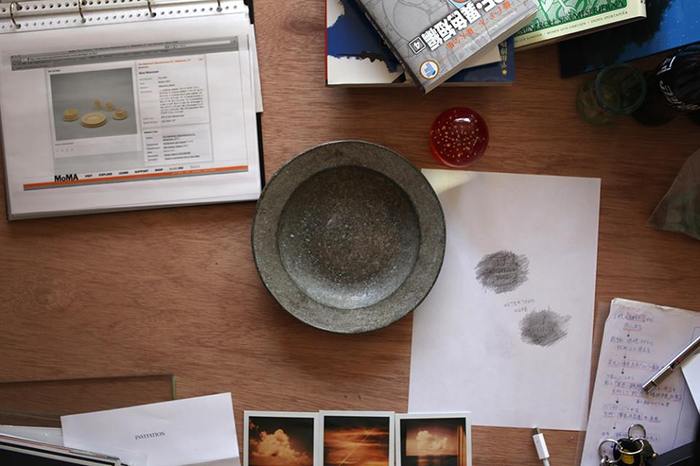皿と月 Dish and the moon
沖縄の古道具市でこの皿を見つけた。たたいてみるとカンカンと金属の音がした。古道具市の亭主はこれが「ジュラルミン製の皿」だと教えてくれた。2000円。
読谷村の民族博物館で同じ物をみつけた。「村で家の立て替えとかの時に捨てるのはもったいないからと博物館に集まってくるんです」の学芸員の方は教えてくれた。
読谷村には戦中に日本軍の飛行場があり、戦後に破壊された戦闘機が沢山放置された。その戦闘機の残骸を材料に、地元のナベ屋“ナービヤー”が溶かして型に流し込んで作ったものがこの皿。ジュラルミン製民具製造が地域の第一産業にまでなった。しかし5年ほどで、戦闘機の残骸を使い切り、ジュラルミン民具産業は徐々に消えたという。
皿の裏の高台を見ると、何やら型を作ったときの元の皿の文様が残っているに気がついた。紙と鉛筆でこすってみると「WATRTOWN WARE」という文字が解読できた。ネットで調べてみると、ニューヨーク近代美術館に収蔵されたプスチック製の皿と全く同じ形だった。1944年に海軍によって作られた強化プラスチック製の皿で、今ではデッドストックだと言う。
戦時中か戦後に、アメリカによって持ち込まれたプラスチック製の皿は、沖縄のナベ屋さんの手に渡りこの皿の鋳込みの型になったのだ。
アメリカと日本による悲惨な戦場になってしまったこの小さな島で、戦後その二つの国家が捨てていったモノを、沖縄の職人が混ぜ合わされて結晶化した民具。重たい歴史を抱えた小さな「モニュメント(歴史的記念碑)」でもあるこの皿は、今から新たに料理をのせることができる空っぽの器でもあり実に軽やかで可能性に満ちている。光を当てると、影が現れ、鈍く銀色に輝いていた皿を眺めながら、「月」のようだと思った。
沖縄の土地で、この皿は博物館の隅の「戦争」もしくは「戦後の貧しい時代」のコーナーに置かれている。僕がこれを、この土地で展示しても「あぁ、あの民具ね。。」というふうにしか思われないだろうと想像した。ただ、この皿をそのまま見せても、少しいつもと違ったふうに感じることは可能なのではないか、と考え始めた。これは『戦争のかたち』と同じ思考かもしれない。
海岸で流れ着いたゴミから見つけた漂着瓶を加工して作った「漂泊グラス」と「ジュラルミンの皿」並べてみると、今回の取材と制作の興味が、”様々な時間や移動を内包した物体”だったのではないかなぁと思った。そして、重要なのは、表面的な造形ではなく、いくつかの素材の出会い方であり、身近な日常の存在の中にそれを見つけたいのだと言う風に思った。
Dish and the moon
I found this dish at the antique market in Okinawa. When I knocked it I could hear metal sounds. The master of the antique shop told me that this was a “duralumin dish.” The price was 2,000 yen.
I found the same objects in the Ethnographic Museum of Yomitan village. “They brought them into the museum because they should not have been to thrown away at the time the houses in the villages were being rebuilt,” the curator explained.
In the Yomitan village, there used to be a Japanese military airfield during wartime. After the war, many destroyed fighters had been left there. The dish that Naviya (the goldsmith) made was formed by taking the wreckages of the fighters and pouring the material into a mold so that it could be dissolved. Duralumin manufacturing had become the main industry in the area. However, in about five years, the rest of wreckage had been used up and the duralumin industry gradually disappeared.
When I looked at the back of the dish, I noticed the remains of the original pattern; probably made when the model was molded. When rubbed with pencil on paper, I recognized the words “WATERTOWN WARE.” I searched on the Internet and found that exactly the same shape of dish in plastic has been kept in the collections of the Museum of Modern Art, New York. In 1944, the same type of dishes, in reinforced plastic resin produced by USA NAVY, were now dead stock. During the war or after the war, plastic resin dishes were brought by the United States to Okinawa. One of them subsequently became the mold for at casting Nabeya’s factory.
It is a crystallization of the works by
Okinawa craftsman, which fuses the things that two nations, Japan and America, abandoned in the tragic battlefield of this small island in World War II.
This dish would be a small monument, containing this heavy history but also empty enough to serve cuisine; hence, it would be lighter and full of potential. When I cast light on it, it appeared as though a shadow shined dully in silver. It looked like moon, I thought.
